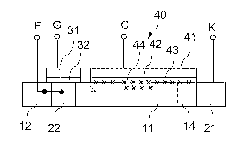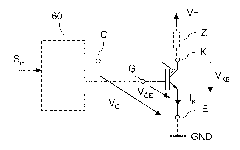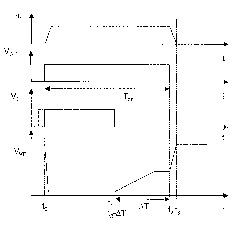Controlling the recombination rate in a bipolar semiconductor component
A recombination rate, semiconductor technology, applied in the direction of semiconductor devices, electrical components, electronic switches, etc., can solve the problems of reducing the robustness of components, low on-resistance, etc.
- Summary
- Abstract
- Description
- Claims
- Application Information
AI Technical Summary
Problems solved by technology
Method used
Image
Examples
Embodiment Construction
[0019] figure 1 A cross-sectional view of a bipolar semiconductor element is schematically illustrated, which in the present exemplary embodiment is realized as an IGBT. The component comprises a first base region 11 of the first conductivity type, a first emitter region 12 of the first conductivity type and a second emitter region 21 of the second conductivity type. The base region 11 is arranged between the first and the second emitter region 12 , 21 and has a lower doping concentration than the emitter region 12 , 21 . The doping concentration of the first and second emitter regions 12, 21 is, for example, 10 15 cm -3 and 10 21 cm -3 In the range in between, the second emitter region 21 may be doped lower than the first emitter region 12 . The doping concentration of the first base region 11 is, for example, 10 12 cm -3 and 10 15 cm -3 in the range between. The doping concentration of the first base region 11 and its size in the current flow direction of the compo...
PUM
 Login to View More
Login to View More Abstract
Description
Claims
Application Information
 Login to View More
Login to View More - R&D
- Intellectual Property
- Life Sciences
- Materials
- Tech Scout
- Unparalleled Data Quality
- Higher Quality Content
- 60% Fewer Hallucinations
Browse by: Latest US Patents, China's latest patents, Technical Efficacy Thesaurus, Application Domain, Technology Topic, Popular Technical Reports.
© 2025 PatSnap. All rights reserved.Legal|Privacy policy|Modern Slavery Act Transparency Statement|Sitemap|About US| Contact US: help@patsnap.com



